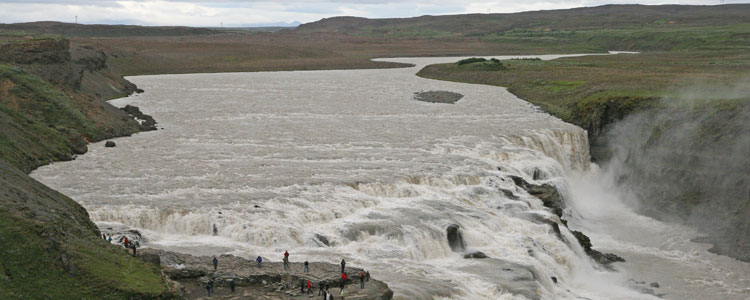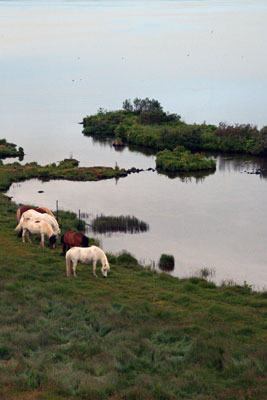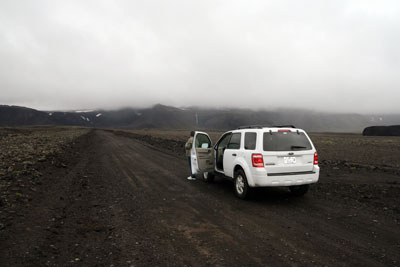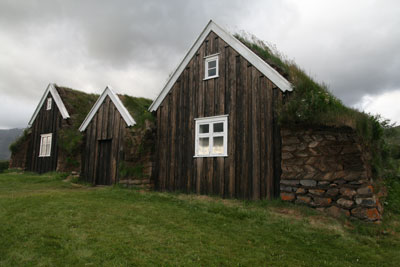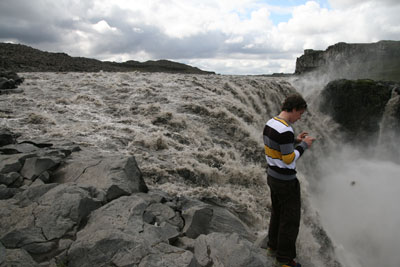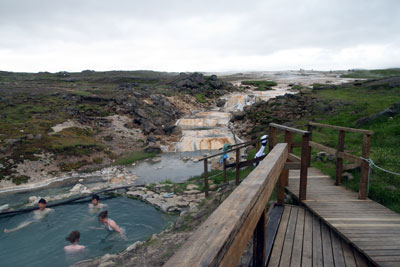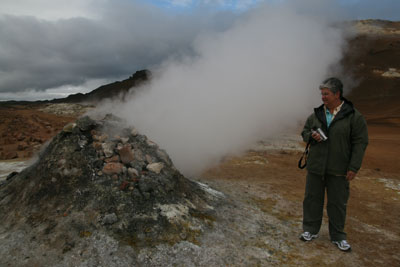Impressed on an independent driving tour of Iceland
by Bill Reed, Denton, TX
It was a short flight, by overseas standards, from Boston to Reykjavík and we arrived near the crack of dawn. After passing through what amounted to virtually no Customs check at all, we were met by a taxi driver holding a sign with our name on it. He took us to Hótel Frón (22A Laugavegur Street), located on a one-way street that turned out to be where most of the activity was.
When we got there, the early-morning street sweepers had just passed by and not a trace of the previous night’s reveling could be seen. Reykjavík and, as I was to learn, the rest of Iceland is squeaky clean.
We also discovered that everybody there can speak English. The native language is as close to the language the Vikings spoke as you can get, and in some places they can read the Old Norse sagas as originally written. I sat at a sidewalk table, beer in hand, and just listened to the words flowing around me, thinking that this was close as I would get to Erik the Red, Bjarnin Herjólfsson or any other of those brave souls who discovered the New World long before Columbus was born.
Heading out
At one time, Iceland was the most expensive country to visit, but the recent recession has taken some of the edge off — though not much. Expect to pay at least double the price for meals and attractions as you would at home. A beer for me and a glass of wine for my wife, Betty, would set us back $20-$30, depending on where we were.
The best thing to do is just get over it and marvel at the place you are in.
Also, it rains a lot in Iceland, but, just like the price of things, you have to get over it. My guess is it rained on us just about every day, and some days it rained all day. On the other hand, the rain was so light, it was not a problem.
We both had rain jackets and rain pants, and we needed both. The one place it did not rain was in the country’s interior, which is more like a desert, with virtually no plant life at all.
For our trip arrangements, we used Nordic Visitor (Laugavegur 26, 101 Reykjavík; phone 354 578 20 80), who had created the most complete summary of what we were going to see and what we should expect than any company we have ever used. Along with a bound itinerary, we were given a cell phone, which came in handy when we did not arrive at certain destinations before closing time. I would recommend this agency without hesitation.
We rented a four-wheel-drive vehicle to be able to see the interior of the country. Gas cost about $6 per gallon, so it can become a significant expense.
Iceland seems huge. Though it’s 40% smaller than Florida, it has nearly 2½ times the coastline. It is as if somebody took pinking shears and trimmed the country’s edges into an endless series of fjords. We found never-ending beauty as we rounded each turn (and there were many) in the road.
What appeared to be a short distance on the map would take some time to cover because of the winding path that had to be taken, but it was that winding path that made it all worthwhile. The landscape varied from lush hills to green fields with hay that appeared to glow in the sun and on to barren land with nothing but stones as far as the eye could see.
Rugged and rocky
After picking up our Ford Escape, we decided to take the long route along one of the many fjords. That night we stayed at Dæli.
Now, one would think Dæli was a place, like a town or something, but it isn’t. It’s a farm that has been turned into a destination for people from the city. You can fish, hike, rent a room (we did), tent camp or park your camping trailer there.
From Dæli we headed toward Akureyri, with a population of about 17,000 people. On the way, we went to Siglufjörður and its herring museum. This was worth the trip, if for nothing else than the scenery.
At this point, it seems appropriate to talk a little about the roads in Iceland. There is one main, paved road that circles the country, with other paved roads leading to significant towns. The rest go from packed dirt to those categorized as “F” roads, which contain a variety of dips, holes, rocks and streams. This is why we needed the four-wheel-drive vehicle.
We live in Texas, which is about as flat as you can get. If you drive off the road, you'll fall a maximum of about four feet. In Iceland, if you drive off some of the roads, you'll fall to your death!
The roads are, by our standards, narrow. On the good side, there is very little traffic.
I am sure that those who drive it all the time have no problem, but the road to Siglufjörður in dense fog was an experience in itself!
The herring museum is an old building containing remnants of the herring trade, which died out about 50 years ago. I wanted to get an idea about the number of visitors they had each day, since we were the only ones there. The attendant said they averaged 10 to 15.
Next we were off to Goðafoss. A huge amount of water flows over these 12-meter-high falls.
The waterfalls in Iceland are like no others we have seen. Not only are they huge, they are glacier fed. As a result, the water is a milky gray.
What struck us most was the fact you could go right to the edge of the falls. It was refreshing to see that visitors have complete access to the falls. Apparently, lawyers have not yet discovered Iceland.
We passed part of Lake Mývatn on the way to Akureyri, but the rain and fog prevented us from taking pictures of the many small islands that studded the lake.
After an overnight at Hotel Reykjahlid, we left Mývatn and headed toward the Hverfell geothermal area. It was not crowded, and we felt like we had the place to ourselves.
The whole area was one large geothermal basin, with red, yellow and brown sand and rocks covering the ground. The mountains looked as if somebody had painted them various colors, and every now and then a wisp of steam would emerge from a small mound of earth.
Wild rides
If you are looking for tourist attractions in Iceland, you might be disappointed, but if you are looking for beautiful scenery and a very laid-back atmosphere, this is the place for you. The towns are small — some have only one hotel — and the places of interest are far apart. It is the land, itself, that is the draw.
Jökulsárgljúfur (okay, you try to pronounce that!) canyon, big enough to house a small city, is something to see. It is believed that two catastrophic floods caused by volcanic eruptions that melted portions of a glacier — the second occurring about 2,500 years ago — created Jökulsárgljúfur in just a matter of days. I stood there and tried to imagine the immense amount of water required to carve the sharp, clean cliffs in such a short time.
Then it was on to the Fosshótel in Húsavík. We stopped in a little store and asked for directions to the hotel. As it turned out, the lady behind the counter used to own the place and knew exactly where it was. After a few short blocks, we were there.
That afternoon we boarded a small boat to go looking for whales. Early on we saw a minke whale for about two seconds, but the rest of the time was spent braving the cold wind and rain.
The fairly strong winds had raised the seas and, although I liked it, it made crossing from one side of the boat to the other a challenge. I don’t think I have held hands with so many complete strangers in my life, but that was the only way to reach the other side without ending up in their laps!
It was a good trip and was fun, but actually seeing a whale or two would have been nice — not that the boat captain didn’t try.
The next morning we went to Vahrmalið, where we had scheduled a three-hour horseback ride. Icelanders are very proud of their horses, which are descended from the original stock brought by the Vikings.
Unfortunately, about halfway through our ride Betty was thrown from her horse. By sheer luck, she landed between all the rocks on the ground, though on the way down she caught her foot in the stirrup. Fortunately, the horse just stood there while staff members got her loose.
She was pretty bruised, and getting in and out of the car for the rest of the trip was painful, but it all ended well (though I think she has probably taken her last horseback ride).
Crowdless touring
From there it was a short drive to Hólar, where we stayed in a college dormitory that offers rooms for travelers in the summer. The school, almost empty at the time of our visit, sits at the head of a valley guarded on both sides by steep green mountains. Students are trained to run hotels and restaurants.
Our buffet-style meal there was excellent.
Next to the main building sat three sod houses, restored to their original condition. The main entrance was opened sometime early in the morning and visitors could go in and have a look around. Icelanders seem to be a very trusting people who think others know enough not to damage what they are looking at, and, from what I could see, they’re right.
From Hólar we turned left onto the Kjölur highway. It was the start of about 150 miles of dirt-and-rock road that cut directly through the center of the island. Some people want it paved because it cuts the trip from Akureyri to Reykjavík in half, but others want it left just as it is because it offers a unique perspective of the country. If it were paved, the interior would lose some of what you go there to see.
The road climbs the foothills and more or less levels out, the landscape turning from hay farms to land so rough, only sheep can graze. The roughness is caused by repeated freezing and thawing of the land, which pushes up humps of earth about a foot and a half.
Returning to Reykjavík
We stopped at three main attractions on our way back to Reykjavík.
At the Hveravellir hot springs, you can soak in a hot pool if you can stand the very cold wind and the fact you have to change clothes in full view of the other bathers. Neither of these conditions seemed to affect either the bathers or the rest of us. It’s a brave soul who can be buck naked in front of a small crowd in 40-degree weather with a brisk wind at his backside!
As at other geothermal areas, you can get very close to the features. Apparently, Icelanders also think people must be smart enough not to stick their fingers in the boiling water, and, since we didn’t see any kids hopping up and down holding their fingers, I think they’re right. Trust is a good feeling.
Next it was on to Gullfoss, another spectacular waterfall, before continuing down the dirt road. After about six hours, the dirt road ended as abruptly as it started, and, to be honest, I missed it.
I felt both good and sad about getting back to Reykavík. Outside the city, things are far apart and you are by yourself much of the time. Once back in the city, we had to worry about traffic, stoplights, a quick succession of street names we could not read and not wanting to hold anybody else up.
We discovered that there are two Icelands: Reykjavík and all the rest. Each is worth seeing and each has its advantages and disadvantages.
We got back to Reykjavík around 8 p.m. for one more night at Hótel Frón. It was Saturday night and we could hear music from the bars all night long. It was only the street sweepers early in the morning that finally cleared the last of the revelers off the streets and picked up the hundreds of empty plastic cups. These people know how to party!
It has been hard for me to describe exactly what we saw, but there was not a time when we weren’t excited about what we were seeing. I do wish we had tried to take in less and spent more time looking at individual places, but you don’t know that until you have gone.
The total cost for our 16-day trip (including visits to the Faroe Islands and Greenland), booked through Nordic Visitor, was ISK1,332,107 ($11,369). This included accommodations and our rental car as well as our whale-watching and horse-riding excursions.
Go to Iceland. It is well worth the trip.
The account of Bill and Betty’s journey continues next month as they travel to the Faroe Islands and Greenland.

